Komachi Area
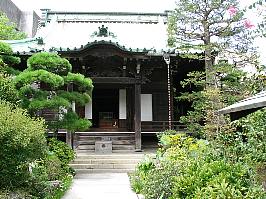 Full name:@Kinryuzan Hokaiji (à´Róú)
Full name:@Kinryuzan Hokaiji (à´Róú)
Denomination:@Tendai sect (Vä@)
Location:@Four hundred meters north-east of JR Kamakura Station
History:@The inscription on the stone monument at the entrance to Hokaiji Temple tells us that this
property was once the residence of the Hojo clan@(kð), who controlled the Kamakura government for
generations. After the Hojo were defeated in 1333 by the imperial forces headed by Nitta Yoshisada@(Vc`
å), the remaining members committed suicide. Later, Emperor Go-Daigo@(ãçíVc, 1288-1339)@ordered
Ashikaga Takauji («¸, 1305-58) to build a temple here in the memory of the Hojo.
Grounds and structures:@The Main Hall, open to worshippers, houses an image of Jizo Bosatsu in the
center (designated an Important Cultural Property). This Jizo is popularly called Kosodate Kyoyomi Jizo (q
çoÇn ), gChild-rearing and Sutra-chanting Jizo.h A record found within the statue revealed that the
image had been made in Kyoto in 1365 by Sanjo Hoin Ken'en (Oð@ó~), a priest. The two images of
Taishakuten (éßV) and Bonten (V), that flank Jizo, are thought to have been carved around the same
time. In front of them are statues of Juo (\¤); to the right are images of Emma Daio (è
å¤) and Hojo
Takatoki, and to the left are images of Fudo Myoo (s®¾¤) and Juntei Kannon (yãñϹ).
@@@The temple also has an image of priest Yuiken (Ò«) (an Important Cultural Property), and a painting
of Butsu Nehan Zu (§¸Ï}), in which Shakyamuni, in the state of Nirvana, is shown lying on his death bed
surrounded by lamenting disciples, bosatsu, guardians, and even animals (designated an Important Cultural
Property by Kanagawa Prefecture). Both are not open to the public view.
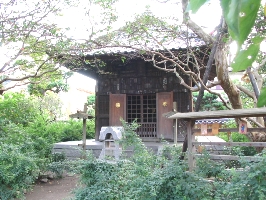
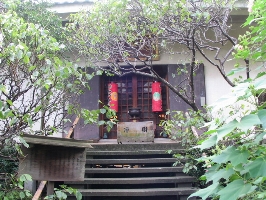
@@@To the right of the main hall are two halls. One is the Taishido Hall (¾q°) dedicated to Shotoku
Taishi (¹¿¾q, 574-622), a statesman and the founder of Horyuji Temple (@²) in Nara, depicted here
as a monk The other is a hall dedicated to Kangiten (½ìV), a secret object of worship. Coming from one
of the Hindu divinities, this was joined as a Buddhist protector. Kangiten is generally depicted as
figures, a male and a female with elephant heads, tightly embracing each other. Thus Kangiten is widely
worshipped for wealth, conjugal harmony, childbirth, and even cure of diseases.
Hokaiji Temple is often known as Hagidera () or gBush-Clover Temple,h referring to the abundance of
Japanese bush clover (hagi), that come into flower in the fall.
|
|
Toshojibashi Bridge (´)
|
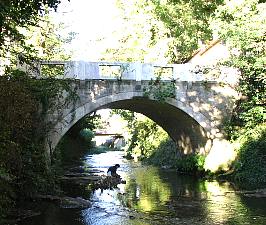 @@@Toshobashi Bridge spans the Namerigawa River on the way to the former site of Toshoji Temple. This
ferroconcrete bridge was built after the Great Kanto Earthquake of 1923. Its beautiful shape matches the
surroundings and contributes to the peaceful atmosphere. The best time to visit this bridge is in the fall
when the leaves have turned red and gold.
@@@Toshobashi Bridge spans the Namerigawa River on the way to the former site of Toshoji Temple. This
ferroconcrete bridge was built after the Great Kanto Earthquake of 1923. Its beautiful shape matches the
surroundings and contributes to the peaceful atmosphere. The best time to visit this bridge is in the fall
when the leaves have turned red and gold.
@@@In 2001, the bridge was designated an Important Structure of Scenic Beauty. At the foot of the
bridge, a stone monument marks the site of the residence of Aoto Fujitsuna, a warrior of the mid-13th
century.
@@@There is a story connected with this warrior. One evening, Fujitsuna accidentally dropped some small
change in the river around here. Most people would not have taken the trouble to try to retrieve such a
small amount, but he was determined to recover every last coin. People laughed at his seeming stupidity,
saying that he was gpenny-wise and pound-foolish.h In reply, Fujitsuna said, gYou donft understand the
real meaning of loss.h gThe coins,h he continued, gif left in the river, would be lost for good. But I
spent that money on torches and it went into the pocket of the merchant. From there, it will pass from
person to person.h
|
|
The site of Toshoji Temple (Õ)
|
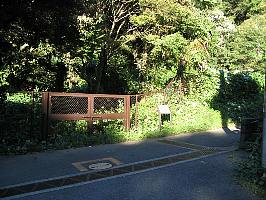 @@@Toshoji Temple was the final refuge of the Hojo clan, who destroyed themselves here in 1333 after
being defeated by the forces of Nitta Yoshisada. Hojo Takatoki, the head of the Kamakura government,
together with his family and his men, fled from their residences in the grounds of Hokaiji Temple to this
place which was their family temple. Takatoki and some eight hundred followers all committed suicide. The
site is significant in that it represents the place where the Kamakura government came to an end after
ruling for 150 years.
@@@Toshoji Temple was the final refuge of the Hojo clan, who destroyed themselves here in 1333 after
being defeated by the forces of Nitta Yoshisada. Hojo Takatoki, the head of the Kamakura government,
together with his family and his men, fled from their residences in the grounds of Hokaiji Temple to this
place which was their family temple. Takatoki and some eight hundred followers all committed suicide. The
site is significant in that it represents the place where the Kamakura government came to an end after
ruling for 150 years.
|
|
The site of the Utsunomiya-zushi bakufu (Fs{{Õ)
|
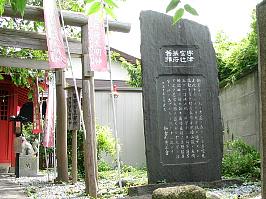 @@@A stone monument marking the site of the Utsunomoya-zushi bakufu stands a little set back behind the
Kamakura-bori Kaikan building on the Wakamiya-oji avenue. In 1180, Minamoto no Yoritomo entered Kamakura
and first established the government at Okura, one kilometer northeast from here. The Okura bakufu lasted
until 1225. After the death of Yoritomo, his widow Masako virtually controlled the government, because
their two sons who succeeded him were incompetent. After the death of Masako in 1225, the government
headquarters were moved to this site in the same year. It was named Utsunomiya-zushi bakufu and continued
here for 11 years until another transfer. The third venue was called Wakamiya-oji bakufu.
@@@A stone monument marking the site of the Utsunomoya-zushi bakufu stands a little set back behind the
Kamakura-bori Kaikan building on the Wakamiya-oji avenue. In 1180, Minamoto no Yoritomo entered Kamakura
and first established the government at Okura, one kilometer northeast from here. The Okura bakufu lasted
until 1225. After the death of Yoritomo, his widow Masako virtually controlled the government, because
their two sons who succeeded him were incompetent. After the death of Masako in 1225, the government
headquarters were moved to this site in the same year. It was named Utsunomiya-zushi bakufu and continued
here for 11 years until another transfer. The third venue was called Wakamiya-oji bakufu.
@@@In those days, the word gzushih in Utsunomiya-zushi meant a convenient pathway set back from the
main road. Many paths had the suffix, gzushi,h including Utsunomiya-zushi, Dengaku-zushi and Daigaku-
zushi.
|
|
The Site of the Wakamiya-oji bakufu (á{åH{Õ)
|
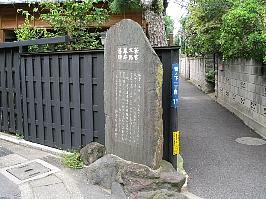 @@@The stone tablet standing along this narrow pathway says this was the site of the shogunate
headquarters at Wakamiya Oji. The place looks too insignificant to have merited such an important function.
When Minamoto no Yoritomo first took over Kamakura, he set up his shogunate in the Okura area, just
northeast of this place. After his death, the actual control of government was taken over by his wife
Masako. When she died, the shogunate building was moved to the Utsunomiya-zushi, about 300 meters to the
south. The headquarters were moved later to this site, where it remained until Kamakura fell to Nitta
Yoshisada in the early 14th century.
@@@The stone tablet standing along this narrow pathway says this was the site of the shogunate
headquarters at Wakamiya Oji. The place looks too insignificant to have merited such an important function.
When Minamoto no Yoritomo first took over Kamakura, he set up his shogunate in the Okura area, just
northeast of this place. After his death, the actual control of government was taken over by his wife
Masako. When she died, the shogunate building was moved to the Utsunomiya-zushi, about 300 meters to the
south. The headquarters were moved later to this site, where it remained until Kamakura fell to Nitta
Yoshisada in the early 14th century. |
|
The former residence of Osaragi Jiro (å§Y@Õ)
|
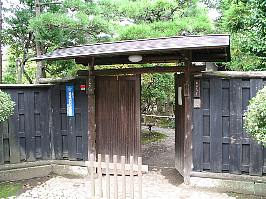 @@@This was the home of the novelist, Osaragi Jiro. He was born in Yokohama in 1897 and as a young man,
he lived in a house behind the grounds of the Great Buddha in Hase, where he wrote his popular historical
novel, Kurama Tengu. In 1929 he moved here to Yukinoshita where he lived until his death in 1972. Osaragi
was one of the central literary figures in Kamakura and was active in the movement to preserve Kamakurafs
natural environment. His ashes are buried at Jufukuji Temple.
@@@This was the home of the novelist, Osaragi Jiro. He was born in Yokohama in 1897 and as a young man,
he lived in a house behind the grounds of the Great Buddha in Hase, where he wrote his popular historical
novel, Kurama Tengu. In 1929 he moved here to Yukinoshita where he lived until his death in 1972. Osaragi
was one of the central literary figures in Kamakura and was active in the movement to preserve Kamakurafs
natural environment. His ashes are buried at Jufukuji Temple.
|
|
Kamakura-bori Assembly Hall @(q¤ïÙ)
|
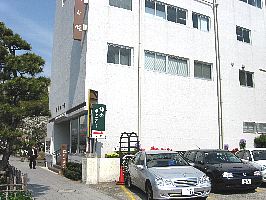
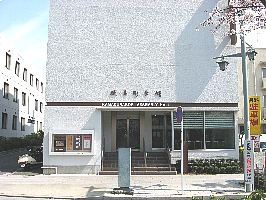
Location: Situated on the right side of Wakamiya-oji Street and close to the Second Gate of Tsurugaoka Hachimangu Shrine.
Facility: The Kamakura-bori Kaikan newly opened in 2006 to provide information and materials relating to
the art of Kamakura carving. Here the visitor can learn about every aspect of Kamakura-bori, its history,
the processes involved, and can admire some of the fine historical and modern masterpieces that are
displayed in its showcases. Videos showing the carving and lacquering processes can be viewed on request,
and booklets in Japanese and English are available.
@@Classes for Kamakura-bori carving are provided: the three-year basic course and
advanced one are open.
Hours: 9:30 - 17:00 (Last Entry 16:30)
Tel: 0467-25-1500
|
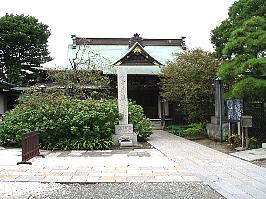 Full name: Eishozan Myoryuji (b¹R²)
Full name: Eishozan Myoryuji (b¹R²)
Denomination: Nichiren sect (ú@@)
Location: Three hundred meters north-eat of JR Kamakura Station.
History: The area is said to have once been occupied by residences of the descendants of the Chiba
clan (çt), influential retainers in the Kamakura period. Tradition at the temple maintains that it was
built by Nichiei (úp), who in 1385 was invited by Chiba Tanesada (çtûå) to serve as the founding
priest.
Ground and structures: The Main Hall houses images of Nichiren (ú@, 1222-82), Nisshin (úe), the
second head priest, and Shaka Nyorai. The hall this side on the right of the Main Hall houses a statue of
Jurojin (õVl), one of the Seven Lucky Gods of the Kamakura-Enoshima area, who brings longevity as well
as safety and health to worshipers. Another stone statue of Jurojin, attended by a deer, stands in front of
the entrance to the temple office on the left.
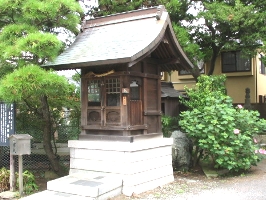
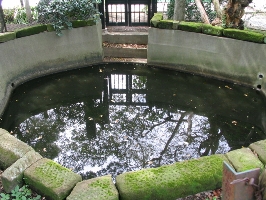
@@@On the right side of the grounds are a pond called Chinoike (Ìr), "Blood Pond," where Nisshin
trained himself rigorously. (See eStoryf)
@@@Further along on the same side is a small hall called
Nisshindo (úe°), which houses a stone image of Nisshin himself.
Story: At the age of 21, Nisshin told himself that he had to be strong enough to endure trials of
any kind if he was to spread the teachings of Buddha. To prepare himself, achieve this, he would first
bathe in the pond on the grounds here and chant sutras, then paint a mandala in India ink mixed with blood
obtained by pulling out his nails. While chanting, he would also plunge his hands into boiling water.
Later, in Kyoto, he wrote out his philosophy in a book called Rissho Chikokuron (§³¡_) and submitted
the dissertation to the sixth shogun, Ashikaga Yoshinori («`³, 1394-1441) as a means of correcting the
shogun's policy. In response, he was arrested and punished by having a heated pot fitted on his head. This
earned him the nickname, Nabekamuri Nisshin, literally gPot-Wearing Nisshin.h
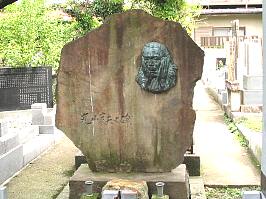
@@@On the right side of the main hall is a stone monument dedicated to the actor Maruyama Sadao (ÛRè
v, 1901-45).
|
|
The site of Nichiren's Street Preaching (ú@ãlÒà@Õ)
|
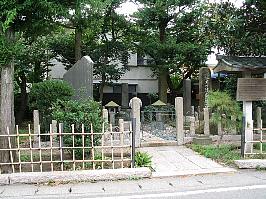 @@@Nichiren, the founder of the Nichiren sect of Buddhism, came to Kamakura to spread his teaching based
on his own interpretation of the Hokekyo (Lotus) sutra. This site commemorates his street preaching
activities. He would stand at crowded street corners and ardently preach his own doctrine. Even from those
days, this street was called Komachi-oji and was a busy area lined with shops and stalls.
@@@Nichiren, the founder of the Nichiren sect of Buddhism, came to Kamakura to spread his teaching based
on his own interpretation of the Hokekyo (Lotus) sutra. This site commemorates his street preaching
activities. He would stand at crowded street corners and ardently preach his own doctrine. Even from those
days, this street was called Komachi-oji and was a busy area lined with shops and stalls.
|
|
Hiruko Jinja Shrine@(gq_Ð)
|
Dedicated deity: Omunachi no Mikoto (åÈM½)
Location: Two hundred meters east of JR Kamakura Station.
History: In the early Meiji period (1867-1912), the shrine gained its present name of Hiruko Jinja and is
the tutelary shrine of the Komachi area. In Japanese mythology, Hiruko was the first offspring of Izanagi (
É÷ø) and Izanami (É÷f). Izanagi and Izanami were progenitors of the Japanese archipelago. Hiruko, in
time, came to be worshipped as Ebisu, one of the seven deities of good fortune. gEbisuh is rendered in
many ways in Japanese writing: bä{AbäõAÎA^Aetc.
Grounds and structures: The Main Hall, leveled by the Great Kanto Earthquake of 1923, was rebuilt in 1933.
An annual festival is held on September 15.
|
|
Daigyoji Temple and Ubusumereijin (å÷ÆYì_)
|
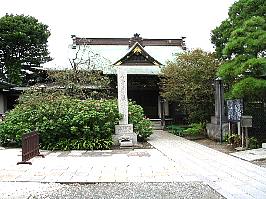 @@@This temple was originally located in Juniso, in the eastern part of Kamakura. In the late 12th
century, Minamoto no Yoritomo planned his military operations at the temple there and achieved a sweeping
victory. As a sign of gratitude he changed the temple name to the present one, meaning gGreat Achievement.
h
@@@This temple was originally located in Juniso, in the eastern part of Kamakura. In the late 12th
century, Minamoto no Yoritomo planned his military operations at the temple there and achieved a sweeping
victory. As a sign of gratitude he changed the temple name to the present one, meaning gGreat Achievement.
h
@@@The main image is Ubusumereijin, known popularly as Ommesama, the guardian of expectant mothers, who
come here with their husbands and family members to pray for a safe and easy birth.
Story:@Omme-sama, responsible for securing safe childbirth, is the popular name for this
temple. Its origin dates back to 1536 when the fifth priest, Nitto (ú) met the wife of a warrior,
Akiyama Kageyu (HR¨ðR). On an early morning Nitton was about to cross the Namerigawa River (ì)
nearby. He saw a woman sobbing on the riverbank, hair disheveled and hugging a very thin baby to her
breast. gWhat troubles you, woman?h Nitto asked. The woman answered, gI am the wife of Akiyama Kageyu (
HR¨ðR). I died giving birth. Every day I have tried to cross this river, but cannot. Help me, I
beseech you.h Nitto answered, gHave faith in Buddha, good woman, and chant sutras everyday. That will
free you from your suffering.h He then began to chant, and when finished, he turned to the woman, but she
was gone.
@@@A few days after, Nitto was approached by a beautiful woman, who said, gI followed your advice,
chanted sutras, and now my sufferings are gone. As a token of my gratitude, I have brought money that I
saved while alive. Please make full use of it,h she continued, gto build a pagoda to save women who
suffer in childbirth.h Nitto then set about building a pagoda dedicated to her as Ubumereijin (Yì_),
responsible for securing safe childbirth, on the grounds of Daigyoji Temple. In time, Ubumereijin came to
be called Omme-sama, and even today many expectant mothers, escorted by their husbands or other family
members, come to pray for a safe and easy childbirth.
|
Hongakuji Temple and the tomb of Masamune,
a celebrated swordsmith ({oÆH³@Ìæ)
|
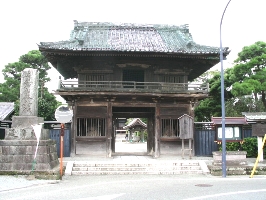
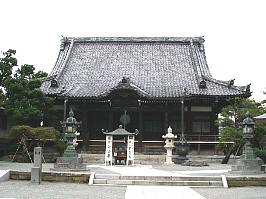
Full name: Myogonzan Hongakuji (µR{o)
Denomination: Nichiren sect (ú@@)
Location:@One hundred and fifty meters south-east of JR Kamakura Station.
History:@Hongakuji Temple was founded in 1436 by Ichijoin Nisshutsu (êæ@úo). Tradition tells
us that Nisshutsu was born at Mishima (now part of Shizuoka Prefecture) and was first a scholar, then later
a priest of the Nichiren sect. When he came to Kamakura, he lived here at Ebisudo Hall (ΰ) and tried to
propagate his teachings. He faced harsh and merciless opposition from other sects, and the result of this
was an order for an arrest by Ashikaga Mochiuji («, 1398-1439), Kamakurafs kubo (Governor-general
of the Kanto Region). Nisshutsu was about to be killed at the execution site. However, according to legend,
Mochiuji got a divine message from the god Ebisu, which brought about a pardon. So impressed was Mochiuji
by this occurrence that he had a temple built on the site where Ebisudo Hall was situated, and dedicated it
to Nisshutsu.
@@@The second head priest was Nitcho (ú©, 1421-1500). His relationship with Nisshutsu began before the
latterfs departure for Kamakura, because Nisshutsu, while still in Mishima, had had a dream in which he
was urged to go to Usami (F²ü), some 20 kilometers south-east of Mishima. Nisshutsu met a boy named
Kyochomaru (¾Û). Nisshutsu accepted him as a disciple and Kyochomaru became the second head priest of
Hongakuji Temple under the name of Nitcho. Because he was so highly revered, he was called a reincarnation
of Nichiren and for that reason, even today, Hongakuji Temple is popularly referred to as Nitcho-Sama (ú©
³Ü).
@@@He left for Mt. Minobu (gR, now in Yamanashi Prefecture) to become Head Priest at Kuonji Temple (
v), the head temple of the Nichiren sect. He then had a portion of Nichiren's ashes taken to Kamakura,
establishing a second head temple so that worshippers could be provided easier access here instead of
having to travel all the way to Minobu. Thus the temple is also called Higashi Minobu (g), gEast
Minobu.h
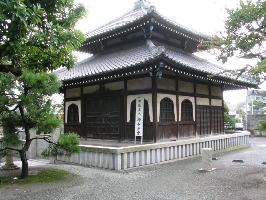
Grounds and structures: The two-story Niomon Gate (m¤å), built in the Edo period (1603-1867), is
the main entrance to the temple grounds. In each recess of the gate is a fierce-looking Nio (m¤), a
guardian deity of a temple. The Nio on the right (as you face them) has his mouth open so that he appears
to be uttering gah (¢),h which means gthe beginning. The other Nio, however, has his mouth closed and
is uttering gun (Ý),h which means gthe ending.h
@@@The Main Hall imposingly stands ahead, with Ebisudo Hall this side on the right. Next to it is a
belfry. Soshi Bunkotsudo Hall (ctª°), which houses part of the remains of Nichiren, is to the right
of the Main Hall.
In the Main Hall is the chief image, Shaka Nyorai (ßÞ@), flanked by Monju Bosatsu (¶êìF) and
Fugen Bosatsu («ìF), and an image of Nichiren. In addition, there is an image of Nisshutsu on the left
end of the altar and an image of Niccho on the right.
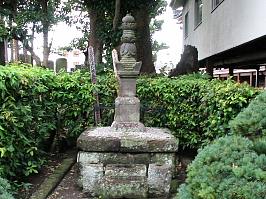 @@@In the graveyard to the left of the Main Hall is a tombstone said to be that for Okazaki Goro
Masamune (ªèÜY³@), a celebrated swordsmith of the late Kamakura period.
@@@In the graveyard to the left of the Main Hall is a tombstone said to be that for Okazaki Goro
Masamune (ªèÜY³@), a celebrated swordsmith of the late Kamakura period.
@@@When Masamune, still a boy, came to Kamakura, Nichiren (ú@, 1222-82) had already taken up residence
in Ebisudo Hall (ΰ). Masamune's father brought Masamun to Nichiren to learn his teachings, and in
return Nichiren gave the boy a new name Masamune, which implies the rightness of the teachings of Nichiren
himself. Because of this connection, the tombstone believed to be that for Masamune is within the grounds
of Hongakuji Temple ({o) .
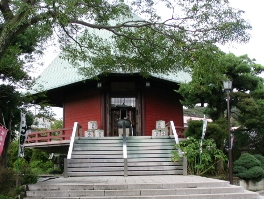 @@@Ebisudo Hall, rebuilt in 1981, is dedicated to Ebisujin (Î_), one of the seven gods of good luck.
Originally it was built by order of Yoritomo (¹©, 1147-99) to protect the government from evil effects,
because this area, when facing the grounds of the bakufu in Okura, was in an inauspicious direction of the
compass: the devil's rear gate.
@@@Ebisudo Hall, rebuilt in 1981, is dedicated to Ebisujin (Î_), one of the seven gods of good luck.
Originally it was built by order of Yoritomo (¹©, 1147-99) to protect the government from evil effects,
because this area, when facing the grounds of the bakufu in Okura, was in an inauspicious direction of the
compass: the devil's rear gate.
@@@This concept of an evil direction originated in ancient Chinese fortune-telling, in which the
northeast and southwest sectors are called kimon (Så) and urakimon ( Så) respectively, and are the
entry and departure points for evil spirits; thus, any activity there must be avoided. Even today, some
people attribute misfortune or illness to a neglect of this belief.
Story: Hongakuji, we are told, is the place to visit for those who have eye problems. Nitcho once said,
gAnyone who has contracted a disease of the eye should call upon me in prayer, for I will then put an end
to the affliction. When I myself suffered from an eye disease, I overcame it by chanting the Hokekyo Sutra
(@Øo).h This story can also be found among Kabuki dramas.
|
|
Ebisudobashi Bridge (롫)
|
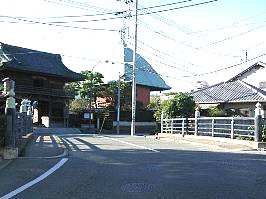 @@@The Ebisudobashi Bridge spans the Namerigawa River and was known as one of the ten major bridges of
old Kamakura. The inscription on the stone monument tells us that the bridge once bordered the bustling
business area of Omachi and the residential area of Komachi.
@@@The Ebisudobashi Bridge spans the Namerigawa River and was known as one of the ten major bridges of
old Kamakura. The inscription on the stone monument tells us that the bridge once bordered the bustling
business area of Omachi and the residential area of Komachi.
@@@The river running under the bridge is Namerigawa. It has as many as six names as it winds its way
from its source in the hills of Juniso to its mouth at Zaimokuza Beach. It is called Kurumigawa around the
upper part of Jomyoji; Namerigawa, around the mouth of the river; Zazengawa near the site of the priest
Mongakufs residence; Ebisudogawa around the Ebisudobashi Bridge; Sumiurigawa around Omachi; and the
Emmagawa around Zaimokuza. Whatever the names, Namerigawa is the only one that need be remembered today.
Yukinoshita Area
|
Kurogane no I Well (SÌä)
|
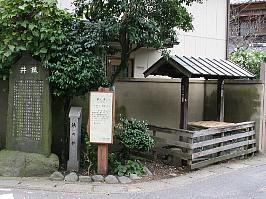 @@@In the corner here, under the little roof is the Kurogane-no-I, or the Iron Well, one of the 10 most
famous wells in old Kamakura. Prior to the introduction of a city water service, people in the neighborhood
and passers-by benefited greatly from this well.
@@@In the corner here, under the little roof is the Kurogane-no-I, or the Iron Well, one of the 10 most
famous wells in old Kamakura. Prior to the introduction of a city water service, people in the neighborhood
and passers-by benefited greatly from this well.
@@@It got to be known by this name after the head section of an iron statue of the Kannon Goddess was
found at the bottom of the well after a great fire that consumed this area and some Buddhist halls.
@@@Later, the head part was transferred to Ningyocho (l`¬) in Tokyo, where even now it is worshipped
as the main image at Daikannonji Temple (åϹ).
|
|
Tsurugaoka Bunko Library (ߪ¶É)
|
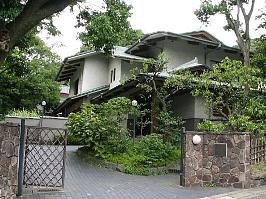 @@@The Tsurugaoka Bunko library houses old documents belonging to the Tsurugaoka Hachiman Shrine and
other historical and cultural records relating to Kamakura. The library holds lectures throughout the year
on the history of this ancient city.
@@@The Tsurugaoka Bunko library houses old documents belonging to the Tsurugaoka Hachiman Shrine and
other historical and cultural records relating to Kamakura. The library holds lectures throughout the year
on the history of this ancient city.
|
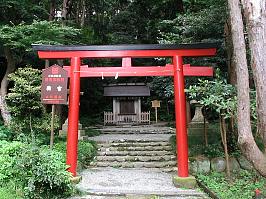 @@@A stone tablet marks the site of a shrine that was known as Imamiya. In 1239, fights broke out
frequently in the town, with the riots of May 25th being particularly violent. This happened to be the day
when the Emperor Gotoba died on the island of Oki, in the Sea of Japan. He had been exiled there after
leading a failed attempt to bring down the Kamakura shogunate. People thought that the disturbances were
caused by the spirit of the dead emperor seeking vengeance, so a shrine was built here to appease his
spirit as well as those of his son Juntoku and grandson Chukyo.
@@@A stone tablet marks the site of a shrine that was known as Imamiya. In 1239, fights broke out
frequently in the town, with the riots of May 25th being particularly violent. This happened to be the day
when the Emperor Gotoba died on the island of Oki, in the Sea of Japan. He had been exiled there after
leading a failed attempt to bring down the Kamakura shogunate. People thought that the disturbances were
caused by the spirit of the dead emperor seeking vengeance, so a shrine was built here to appease his
spirit as well as those of his son Juntoku and grandson Chukyo.
|
The former site of Nijugobo,
Twenty-Five Boarding House for Monks (ñ\ÜV)
|
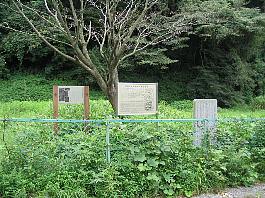 @@@The stone monument indicates the site of Nijugobo, where there were 25 boarding houses for monks.
Until the early Meiji period, Tsurugaoka Hachiman incorporated both Shinto and Buddhist beliefs and was
known as Tsurugaoka Hachimanguji, that is, Hachiman Shrine and Temple. In those days, Tsurugaoka
Hachimanguji was administered by monks and this is where they would have been housed. Nijugobo has the
notorious fame of being the place where the monk Kugyo took refuge, after slaying the third shogun Sanetomo
in the 13th century.
@@@The stone monument indicates the site of Nijugobo, where there were 25 boarding houses for monks.
Until the early Meiji period, Tsurugaoka Hachiman incorporated both Shinto and Buddhist beliefs and was
known as Tsurugaoka Hachimanguji, that is, Hachiman Shrine and Temple. In those days, Tsurugaoka
Hachimanguji was administered by monks and this is where they would have been housed. Nijugobo has the
notorious fame of being the place where the monk Kugyo took refuge, after slaying the third shogun Sanetomo
in the 13th century.
@@@In 1872, the Meiji government ordered the separation of Shintoism and Buddhism, and Tsurugaoka
Hachiman Shrine and Temple became just a shrine, and the monks became Shinto priests.
@@@This is the scene of many historical events, and it is also significant as the birthplace of the
Ancient Capital Preservation Law. After the Second World War, a housing project was mapped out for this
area, but the citizens of Kamakura mounted a campaign against the plan. In the end the area was saved and
kept as it was. Their activities brought about the enactment of the monumental law.
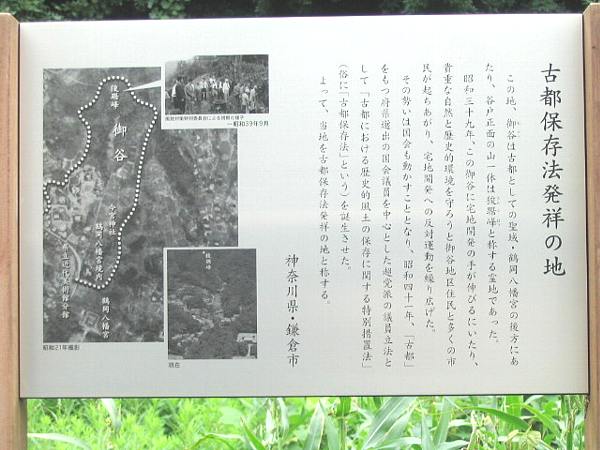
|
|
Kobukurozaka Pass@(Câ)
|
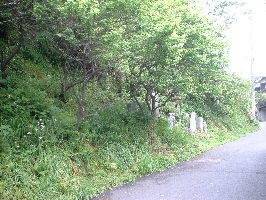
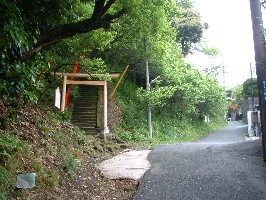
Location:@One kilometer north of JR Kamakura Station.
Site:@Kobukurozaka Pass was one of the seven passes leading into old Kamakura. The present one was
constructed around 1883 and the old path, although closed at the hillside now, partly runs parallel to the
new one.
@@@The old one started from the west side of the Hachimangu Shrine grounds, and ran up the hillside in
front of Omeshoten Shrine (Â~¹V), and led to the front of Ennoji Temple (~), afterwards emerging
in front of Kenchoji Temple (·). Part of the trail is designated a Historic Site by the
government.
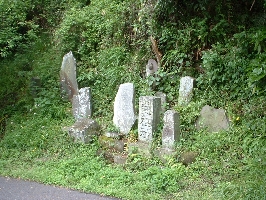
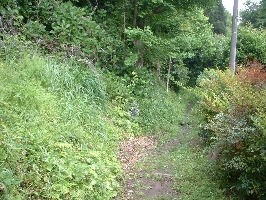
Story:@When Kamakura was attacked by the forces of Nitta Yoshisada (Vc`å, 1301-38) in 1333,
this became one of the three routes through which the enemy of the Hojo government rushed into the center
of the city.
|
The Former Site of the Residence of Hatakeyama Shigetada@
(©RdÌ®~Õ)
|
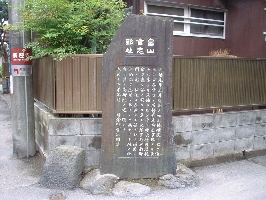
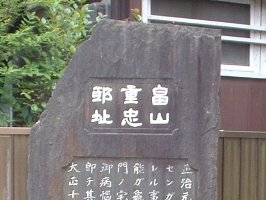
Location:@One kilometer northeast of JR Kamakura Station and close to the east gate of the
Hachimangu Shrine. Nearby is Yokohama Kokuritsu Daigaku Fuzoku Sho-Chugakko (¡l§åwt®¬AwZ,
the Elementary and Junior School Annex of Yokohama National University).
Site:@The residence of Hatakeyama Shigetada (©Rd, 1164-1205), an important Yoritomo retainer,
once stood to the south of the school. A stone monument marks the site.
History:@When Yoritomo rose up in arms against the Taira (½), Shigetada, in Musashi Province (
, now part of Tokyo and Saitama Prefecture), first sided with the Taira clan. After he surrendered to
Yoritomo, Shigetada took a prominent part in Yoritomo's war against the Taira. He soon gained Yoritomo's
trust and became a high-ranking vassal in the government.
@@@Later, however, relations between Shigetada and the shogunal regent, Hojo Tokimasa (kð, 1138-
1215) soured because of Hojofs ambition to gain full control. In 1205, Shigetada was tricked into rising
against the Hojo. Following the death of his son in battle against the Hojo, Shigetada took up arms against
them and was killed in another battle later the same year.
|
The Former Site of the Residence of Miura Yoshimura
(OY`ºÌ®~Õ)
|
Location:@One kilometer northeast of JR Kamakura Station. It corresponds approximately to the
grounds of Fuzoku Sho-Chugakko School.
Story:@The Miura, a powerful warrior family of Sagami Province (Í, most of present-day Kanagawa
Prefecture), was the mainstream of the Taira family. However, Miura Yoshiaki (OY`¾, 1092-1180),
supported Yoritomofs uprising in 1180, with his son, Yoshizumi (`, 1127-1200), his grandson, Yoshimura
(`º, ? -1239), and other family members.
@@@Following Yoritomo's victory over the Taira and the founding of the bakufu, Yoshimura became an
influential retainer of the government and was given a residence near the government offices. Yoshimura
supported the government with the Hojo family. Even when his cousin Wada Yoshimori (ac`·, 1147-1213)
opposed the Hojo, Yoshimura, after due deliberation, took their side.
@@@The Miura thus came to rank second to the Hojo after the obliteration of the Hatakeyama and the Wada.
Yoshimura's son, Miura Yasumura (׺, ?-1247), married a daughter of Hojo Yasutoki (kð×, 1183-1242).
In 1247, however, he was forced into rebellion by the Hojo, who, wanting to consolidate their position in
the government, had a policy of eliminating rivals, real or imagined. Defeated in battle, Yasumura
committed suicide at Hokkedo Hall (@Ø°) in Okura (å ) with more than 250 of his followers.
|
|
Sujikaebashi Bridge (Øá´)
|
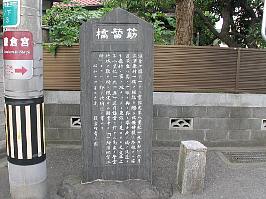 @@@Right at the corner where the road makes a sharp turn, there used to be a bridge that spanned a river
on the diagonal. Because of this unusual layout, it was called Sujikaebashi, literally gOblique-span
Bridge.h It was famous as one of the ten major bridges of old Kamakura, but it was removed in a major
reconstruction of the road in 1955 and the river covered over. The only reminder of the site is the nearby
stone monument.
@@@Right at the corner where the road makes a sharp turn, there used to be a bridge that spanned a river
on the diagonal. Because of this unusual layout, it was called Sujikaebashi, literally gOblique-span
Bridge.h It was famous as one of the ten major bridges of old Kamakura, but it was removed in a major
reconstruction of the road in 1955 and the river covered over. The only reminder of the site is the nearby
stone monument.
@@@Also nearby stood the Miura residence. The Miura, a very influential family, made important
contributions to the founding of the Kamakura military government.
@@@In 1247 the bridge witnessed a battle between the Miura and Hojo clans. The Hojo clan held the role
of regent in Kamakura and they were fearful of the increasing power of the rival Miura. So they carried out
a preemptive strike against the Miura residence. After fierce street fighting, the Miura were defeated.
Those who survived the attack fled into a hall called Hokkedo and committed suicide en masse.
|
Nishimikado
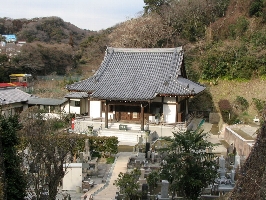
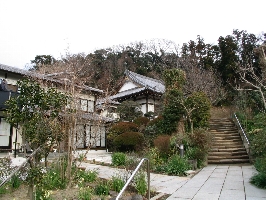
Full name: Mankozan Raikoji (õR})
Denomination: Ji sect (@)
Location: One and a half kilometers northeast of JR Kamakura Station, and to the northeast of
Hachimangu Shrine grounds.
History:@The temple is said to have been built in the 1280s by Ippen (êÕ, 1239-89), the founder
of the Ji sect (@) of Buddhism. The Main Hall was destroyed by the Great Kanto Earthquake of 1923 but
was re-built in 1994.
Grounds:@The temple structures sit on the open space on the hillside. The main hall houses a seated
image of Amida Nyorai in the center, and a statue of Jizo Bosatsu (an Important Cultural Property by
Kanagawa Prefecture) supposedly carved by Takuma Joko (îÔòG) in 1384. Nyoirin Kannon (@ÓÖϹ) on
the right of the main image is a work of the Nambokucho period (1336-92). The statue has colorfully painted
decorative clay patterns and, is designated an Important Cultural Property by Kanagawa Prefecture.
@@@The statue to the left of the main image is Badabarasonja (²Ék
¸Ò), a statue that allegedly
cures pain in the feet, legs and waist. Other possessions include a sambutsuzo (O§) triad, a waniguchi
(kû) gong, literally, gcrocodile mouth,h and a tearai-ishi (èô¢Î), a stone hand-washing
basin.
Legend:@A sad story about the Nyoirin Kannon tells about a man in Yui (Rä), who was living a
luxurious life, with not a care in the world. The man had a daughter he loved very much, but one day a
large eagle swooped down and carried her off. The father frantically searched for his daughter, and
although he eventually found her, she was dead. He interred her remains inside the body of this Kannon for
the repose of her soul.
|
|
The Site of Okura bakufu (åq{Õ)
|
 @@@This area, Okura, was the center of the Kamakura government in its first stage. In 1180, Minamoto
Yoritomo entered Kamakura and established his government in this vicinity, calling it the Okura bakufu. He
also had his residence built here. The government went on to function here for 46 years until it was
transferred to a location near Wakamiya-oji Avenue.
@@@This area, Okura, was the center of the Kamakura government in its first stage. In 1180, Minamoto
Yoritomo entered Kamakura and established his government in this vicinity, calling it the Okura bakufu. He
also had his residence built here. The government went on to function here for 46 years until it was
transferred to a location near Wakamiya-oji Avenue.
|
|
The Tomb of Minamoto no Yoritomo (¹©Ìæ)
|
 @@@This is the tomb of Minamoto no Yoritomo, the founder of the Kamakura bakufu. He was born in 1147 and
died on January 13, 1199 at the age of 52. At the foot of this hill, there used to be a temple called
Hokkedo, built at the order of Yoritomo himself, and it is said he used to worship here daily. The shrine
on the left side of the stone steps is Shirahata Jinja, literally, the White Banner Shrine. The white
banner was the symbol of Yoritomofs family, Minamoto, which is also known as Genji. The shrine itself was
built in the early Meiji period.
@@@This is the tomb of Minamoto no Yoritomo, the founder of the Kamakura bakufu. He was born in 1147 and
died on January 13, 1199 at the age of 52. At the foot of this hill, there used to be a temple called
Hokkedo, built at the order of Yoritomo himself, and it is said he used to worship here daily. The shrine
on the left side of the stone steps is Shirahata Jinja, literally, the White Banner Shrine. The white
banner was the symbol of Yoritomofs family, Minamoto, which is also known as Genji. The shrine itself was
built in the early Meiji period.
|
|
The Tomb of Oe no Hiromot (å]L³Ìæ)
|
 @@@This is the tomb of Oe no Hiromoto. He was invited by Minamoto Yoritomo from Kyoto to act as an
adviser in the establishment of the Kamakura bakufu. His contributions are said to have been so great that
the new political system was set in place earlier than expected.
@@@This is the tomb of Oe no Hiromoto. He was invited by Minamoto Yoritomo from Kyoto to act as an
adviser in the establishment of the Kamakura bakufu. His contributions are said to have been so great that
the new political system was set in place earlier than expected.
|
|
The site of Hokkedo Hall (@Ø°Õ)
|
 @@@A stone monument marking the site of the Hokkedo hall stands at the foot of the hill where the tomb
of Minamoto no Yoritomo is located. The hall was built on the personal order of Yoritomo and installed with
Buddhist images, so he could worship here everyday.
@@@A stone monument marking the site of the Hokkedo hall stands at the foot of the hill where the tomb
of Minamoto no Yoritomo is located. The hall was built on the personal order of Yoritomo and installed with
Buddhist images, so he could worship here everyday.
@@@The hall was also the scene of a gruesome incident in 1247. This was at a time when the Hojo clan was
setting up its dictatorship, eliminating one rival clan after another. The Miura clan was the last target
to be annihilated. On June 5, 1247, the Hojo forces led by Adachi Kagemori attacked the Miura residence.
After a fierce battle, the Miura were defeated and forced to retreat into the Hokkedo hall. Here the
remaining members of the Miura clan committed suicide in front of an image of Minamoto Yoritomo. The scene
was witnessed by a monk who had taken refuge from the battle and hidden in the ceiling above.
|
|
The Former Site of the Mongaku Residence@(¶oãl®~Õ)
|
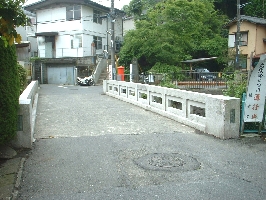
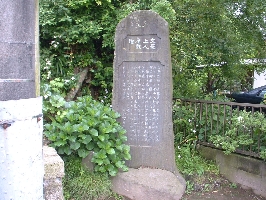
Location:@The site of the Mongaku residence is marked by a stone monument next to the Omidobashi
Bridge (åä°´).
Story:@The main person in this story is Endo Morito (¡·). He was originally a warrior in
Kyoto and later became a monk, taking the Buddhist name, Mongaku. When he was young, he mistakenly killed a
married women, named Kesagozen (U¾äO). She was the wife of his friend, Minamoto no Wataru (¹n). The
two had fallen in love. Much worried about the situation, she asked Morito to come to her home at night and
kill her husband while he was asleep. Morito agreed to this plot and carried it out. Alas, it was not
Wataru that he killed but Kesagozen herself. To show his repentance, Morito entered the priesthood.
@@@Despite this vocation, he reportedly never lost his fiery temper. As a result of his coercive
attitude towards the emperor, Mongaku was exiled to Izu (the eastern part of what is now Shizuoka
Prefecture) in 1178, where, coincidentally Yoritomo had been in exile since 1160. The two often met and
formed close ties.
@@@One story has it that Mongaku urged Yoritomo to take up arms against the Taira. He said persuasively,
Your father Yoshitomo (`©, 1123-60) was killed by the Taira, and you were exiled by them. All your
sufferings were brought about by your sworn enemy, Taira no Kiyomori (½´·, 1118-81).hAt first, Yoritomo
was reluctant, but in the end he was moved by these words. Even after Yoritomo set up the bakufu, the
association between the two men continued for a long time
|
|
The Former Site of Shochojuin Temple@(·õ@Õ)
|
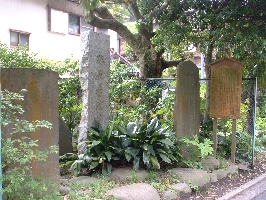
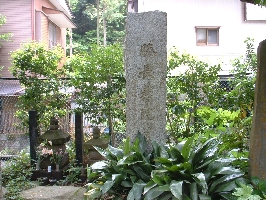
Location:@A little more than one kilometer northeast of JR Kamakura Station.
Site:@A large stone monument and other stones mark the former site of Shochojuin Temple.
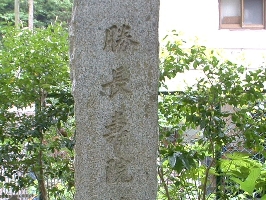
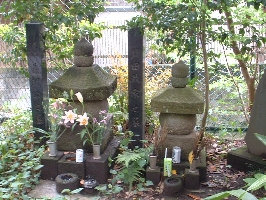
Story:@Minamoto no Yoritomo (¹©) had a long-pending project in his mind while he was fighting
against the Heike and establishing his government. This was to create a suitably grand temple for the
repose of the soul of his father, who had died an ignominious death, and eventually, in 1185, Yoritomo had
the temple completed at this site.
@@@His father Yoshitomo (`©, 1123-1160) had been a leading warrior in Kyoto. Yoshitomo and Taira no
Kiyomori (½´·, 1118-81) had fought on the same side in the Hogen Disturbance (Û³Ì) of 1156. But
soon after, they became rivals. In the 1159 Heiji Disturbance (½¡Ì), Yoshitomo was defeated by
Kiyomori and tried to flee from Kyoto to the east. However, he was betrayed and killed by a man he had
trusted. The man was still under the influence of the Heike.
@@@Some 20 years later, Yoritomo asked the cloistered Emperor Go-Shirakawa (ãÍ@c, 1127-92) to
permit the construction of a mausoleum for Yoshitomo. In response, the Emperor had Yoshitomo's head found
and sent to Yoritomo in 1185. The temple dedicated to Yoshitomo was said to have been truly grand.
@@@The third shogun, Sanetomo (¹À©, 1192-1219), had close ties with this temple. On a visit one rainy
spring morning, he composed a poem, which roughly translates as follows:
@@@@@@In this old temple,
@@@@@@Flowers on the decaying plum tree come forth,
@@@@@@Enticed by the drizzling spring rain.
@@@On January 28, 1219, the day following his assassination, Sanetomo was buried here. Prior to his
departure to Hachimangu Shrine where he met his death, he composed a poem of farewell, which suggests to us
that Sanetomo was aware of the fate that awaited him.
@@@A gorinto-type stupa, said to be Yoshitomo's tombstone, also once stood here, but there is now no
trace of it or of the temple itself. Shochojuin, Tsurugaoka Hachimanguji (ߪª¦{) and Yofukuji (i
) Temple were counted among gthe three major temples of Kamakurah, but Shochojuin was destroyed in the Muromachi period.
|
|
|